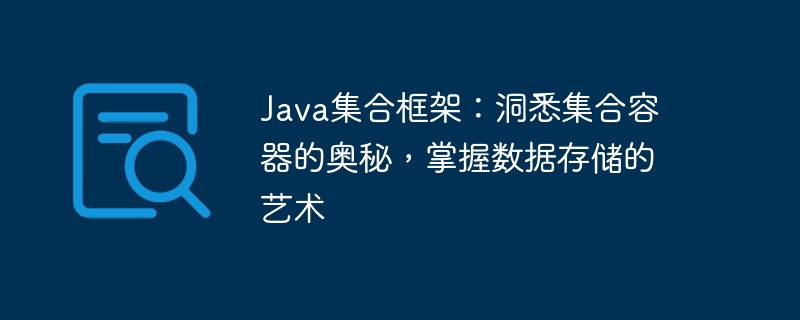Home >Java >javaTutorial >Java Collection Framework: Understand the mysteries of collection containers and master the art of data storage
Java Collection Framework: Understand the mysteries of collection containers and master the art of data storage
- WBOYWBOYWBOYWBOYWBOYWBOYWBOYWBOYWBOYWBOYWBOYWBOYWBforward
- 2024-02-23 11:34:05489browse

The Java collection framework is one of the important basic knowledge in Java programming. It provides a convenient solution for data storage and management. PHP editor Youzi will give you an in-depth explanation of the mysteries of the Java collection framework and help readers master the art of data storage. In this article, we will discuss the internal implementation principles of collection containers and how to choose the appropriate collection class according to different needs, allowing readers to have a deeper understanding and application of the Java collection framework.
JavaCollectionsFramework is a large and complex system, which contains various collectionsContainers. These containers can be classified according to the type of data they store, access methods, threadingsecurity and other characteristics. In general, the Java collection framework mainly includes the following types of collection containers:
-
List (List): List is one of the most common data structures, which allows you to store and access data in order. Elements in the list can be accessed via index, and elements can be added, removed, and modified.
-
Stack: The stack is a last-in-first-out (LIFO) data structure. This means that elements added later will be removed first. The stack is typically used to store temporary data or function calls.
-
Queue: Queue is a first-in-first-out (FIFO) data structure. This means that elements added first will be removed first. Queues are typically used to store tasks or messages waiting to be processed.
-
Map: Map is a key-value pair data structure. It allows you to store and access data based on keys. The keys in the map are unique, while the values can be of any type.
-
Set operation (Set): A set is a data structure that does not contain repeated elements. Elements in a collection are unique, and elements can be added, removed, and modified.
Advantages of using Java collection framework
The Java collection framework provides many advantages, including:
-
Organize and manage data: The collection framework can help you organize and manage data, making your code easier to read and maintain.
-
Improve performance: The data structure in the collection framework has been optimized , which can improve data access and operation performance.
-
Scalability: The collection framework is scalable, which means you can add or remove data structures as needed without modifying your code.
-
Safety: The data structures in the collections framework are thread-safe, which means they can be safely used in a multi-threaded environment.
Commonly used classes in Java collection framework
Many useful classes are provided in the Java collection framework to help you manage and store data. Here are some of the most commonly used classes:
-
ArrayList: ArrayList is a dynamically sized list that can store any type of object.
-
LinkedList: LinkedList is a two-way linked list that can store any type of object.
-
Stack: Stack is a last-in-first-out (LIFO) data structure that can be used as a LIFO stack or a depth-first search (DFS) tree.
-
Queue: Queue is a first-in-first-out (FIFO) data structure that can be used as a queue or a breadth-first search (BFS) tree.
-
HashMap: HashMap is a hash table that can quickly look up values based on keys.
-
TreeMap: TreeMap is a red-black tree that can sort values based on keys.
Sample code
The following is some sample code that demonstrates how to use the Java Collections Framework to manage and store data:
// 创建一个ArrayList
ArrayList<String> names = new ArrayList<>();
// 添加一些元素到ArrayList
names.add("John");
names.add("Mary");
names.add("Bob");
// 遍历ArrayList并打印元素
for (String name : names) {
System.out.println(name);
}
// 创建一个Stack
Stack<Integer> numbers = new Stack<>();
// 添加一些元素到Stack
numbers.push(1);
numbers.push(2);
numbers.push(3);
// 从Stack中弹出元素并打印
while (!numbers.isEmpty()) {
System.out.println(numbers.pop());
}
// 创建一个Queue
Queue<String> messages = new LinkedList<>();
// 添加一些元素到Queue
messages.offer("Hello");
messages.offer("World");
messages.offer("!");
// 从Queue中弹出元素并打印
while (!messages.isEmpty()) {
System.out.println(messages.poll());
}The above is the detailed content of Java Collection Framework: Understand the mysteries of collection containers and master the art of data storage. For more information, please follow other related articles on the PHP Chinese website!
Related articles
See more- Detailed explanation of Java collection framework LinkedHashSet and LinkedHashMap source code analysis (picture)
- How to check the path of the mapped docker container
- What content is stored in the stack, heap, and method area respectively?
- What is the shortcut key for ae time remapping?
- What is the storage structure of the stack?

